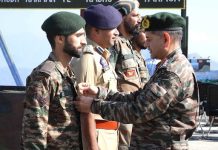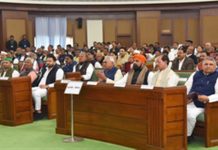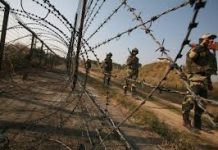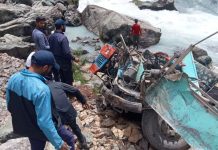
Amidst the ongoing violence that shows no signs of abating, the people of Manipur continue to bear the brunt of the conflict. Displaced and left with no choice but to seek refuge in relief camps, thousands of individuals struggle to rebuild their lives. Barely seven kilometers away from the bustling heart of Imphal, a ray of hope flickers at Praja Higher Secondary School in Lamsang, where a relief camp has been established by the resilient residents of the area. Within its walls, over 80 individuals, including more than 45 school-going children, find solace and safety from the attacks and arson orchestrated by suspected Kuki militants.

The majority of the camp’s residents hail from Phayeng, and many of the children arrived without their parents. These young ones are being looked after by volunteers and a handful of guardians who have come from their respective villages to offer their assistance. Most parents made the difficult decision to send their children to the relief camp in order to protect them from the violence. These kids have big dreams and lofty ambitions, but their future hangs in the balance as the state government, led by N Biren Singh, has been unable to extinguish the fire that has engulfed Manipur for over two months. The continued violence has cast a dark cloud over the hopes and aspirations of these children.
Jackson Huirem, just 11 years old, watched helplessly as his house was set ablaze by a violent mob in Phoubakchao Ikhai, Bishnupur district. Despite this harrowing experience, he still aspires to become an IAS officer. Another child, Rojia Thingom from Phayeng, dreams of becoming a politician and one day serving as a minister. The dreams and aspirations of these children, and many others like them, are being stifled by the current situation and the government’s inability to regain control. As the violence persists, the government keeps postponing the reopening of schools, which only further dampens the children’s hopes.
In a commendable effort to help the children in the camp, Rupachandra Anoubam, a volunteer with a Postgraduate degree in Physical Education, has been conducting physical training classes. Recognizing the need to keep the children healthy and mentally sound, Anoubam started these classes at 6 am every morning, focusing on physical fitness and mental well-being. In addition to physical training, he also provides lessons on various subjects.
Another dedicated volunteer, Roosevelt Irungbam, who is pursuing a Ph.D. in Mathematics at Manipur University, teaches science and mathematics to students from grades 1 to 12. He aims to ensure that these children remain academically engaged and ready to transition back to formal education when normalcy returns to Manipur.
While Mr. Anoubam and Mr. Irungbam are doing their best to make a difference in the lives of these school-going students, Anganwadi workers from the area, including Ms. Mandakini Koijam, Mrs. Bhanu Aribam, and Mrs. Priya Anoubam, have also recognized the importance of providing classes to the younger age groups. Their efforts have been supported by government officials, including MLA Sorokhaibam Rajen Singh, who granted permission to start classes at the relief camp from June 1. Through singing, painting, and other preschool activities, these dedicated individuals are helping the children subside the conflicts in their young minds.
Although the volunteers and Anganwadi officials are doing their best to provide education and support to the children, their efforts alone are not enough. The relief camp relies on the tireless work of women from nearby areas who remain stationed there 24/7, caring for the kids and also tending to the needs of women and young girls, including their health concerns.
Laija Thokchom, one of the volunteers, explains their commitment: “A group of women, including myself, have been staying in the relief camp around the clock to look after the young kids and girls. I even brought my own kids to stay and play with them, making the relief camp feel like a home away from home.”
With over 80 inmates, including more than 45 children, the relief camp requires special attention regarding food, education, and other necessities. The camp’s sustainability depends on support from a few government offices as well as contributions from friends, family, and concerned individuals who have learned about the camp’s plight.
Joykumar Namoijam, another volunteer, appeals to people for help in running the relief camp smoothly. He emphasizes the camp’s independence from any club or organization and states that the current government assistance is insufficient. To provide essentials such as milk, tea, and items for infants, Mr. Namoijam requests support from the public.
Amidst these challenging circumstances, parents and guardians in the relief camp worry about their children’s future. Tilotama Huirem, whose house was burned in Phoubakchao Ikhai, expresses concern for her grandchildren: “Our house has been burned, and so has my grandchildren’s school. Given the ongoing violence, it is unlikely that classes will resume anytime soon. I worry about their future and the education they are missing out on due to the conflict. The government should prioritize restoring normalcy and initiating the rehabilitation process.”
Another relief camp, located 45 kilometers from Imphal at Moirang Lamkhai, just around 500 meters from the historic INA Headquarters, Moirang, was established to accommodate those fleeing clashes in Churachandpur and nearby Bishnupur areas. This camp, alongside a Trauma Response Center (TRC), was set up by Matai Society, an organization focused on skill building and economic development. The Trauma Response Center provides services to approximately 15 young children.
Balleck Moirangthem, a volunteer with the society, highlights the need for government intervention and support for TRC. He states that the center requires various materials, nutritional items, and training for volunteers to better assist the children. Mr. Moirangthem appeals to the government and potential donors to enable the camp and the Trauma Response Center to function optimally, ultimately helping the children return to a sense of normalcy and access proper education. This story sheds light on just two of the more than 300 relief camps that have been established throughout Manipur, providing shelter for over 50,000 displaced individuals. The ongoing conflict has taken a toll on both the people and the students, leaving parents and guardians from Kuki and Meitei communities deeply concerned about their children’s future. While it appears that the government is struggling to quell the violence, it is now crucial for lawmakers to take decisive action in restoring normalcy. In addition, it is vital for individuals to step up as responsible citizens, supporting the government’s efforts to find democratic solutions and bring an end to the suffering.













